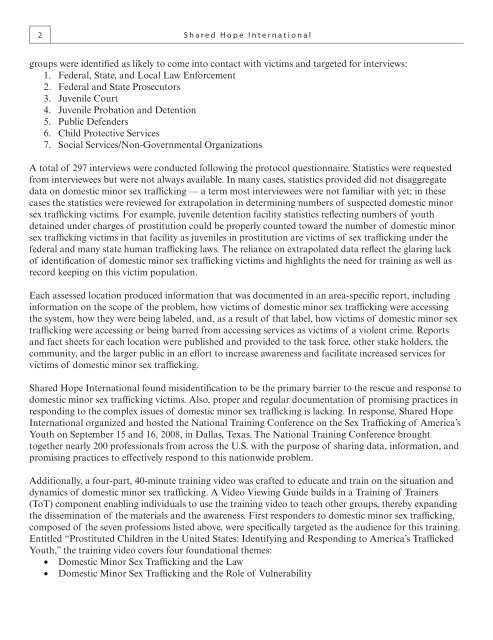By Linda A Smith Samantha Healy Vardaman Melissa A Snow
The National Report on Domestic Minor Sex Trafficking
The National Report on Domestic Minor Sex Trafficking
You also want an ePaper? Increase the reach of your titles
YUMPU automatically turns print PDFs into web optimized ePapers that Google loves.
2Shared Hope Internationalgroups were identified as likely to come into contact with victims and targeted for interviews:1. Federal, State, and Local Law Enforcement2. Federal and State Prosecutors3. Juvenile Court4. Juvenile Probation and Detention5. Public Defenders6. Child Protective Services7. Social Services/Non-Governmental OrganizationsA total of 297 interviews were conducted following the protocol questionnaire. Statistics were requestedfrom interviewees but were not always available. In many cases, statistics provided did not disaggregatedata on domestic minor sex trafficking — a term most interviewees were not familiar with yet; in thesecases the statistics were reviewed for extrapolation in determining numbers of suspected domestic minorsex trafficking victims. For example, juvenile detention facility statistics reflecting numbers of youthdetained under charges of prostitution could be properly counted toward the number of domestic minorsex trafficking victims in that facility as juveniles in prostitution are victims of sex trafficking under thefederal and many state human trafficking laws. The reliance on extrapolated data reflect the glaring lackof identification of domestic minor sex trafficking victims and highlights the need for training as well asrecord keeping on this victim population.Each assessed location produced information that was documented in an area-specific report, includinginformation on the scope of the problem, how victims of domestic minor sex trafficking were accessingthe system, how they were being labeled, and, as a result of that label, how victims of domestic minor sextrafficking were accessing or being barred from accessing services as victims of a violent crime. Reportsand fact sheets for each location were published and provided to the task force, other stake holders, thecommunity, and the larger public in an effort to increase awareness and facilitate increased services forvictims of domestic minor sex trafficking.Shared Hope International found misidentification to be the primary barrier to the rescue and response todomestic minor sex trafficking victims. Also, proper and regular documentation of promising practices inresponding to the complex issues of domestic minor sex trafficking is lacking. In response, Shared HopeInternational organized and hosted the National Training Conference on the Sex Trafficking of America’sYouth on September 15 and 16, 2008, in Dallas, Texas. The National Training Conference broughttogether nearly 200 professionals from across the U.S. with the purpose of sharing data, information, andpromising practices to effectively respond to this nationwide problem.Additionally, a four-part, 40-minute training video was crafted to educate and train on the situation anddynamics of domestic minor sex trafficking. A Video Viewing Guide builds in a Training of Trainers(ToT) component enabling individuals to use the training video to teach other groups, thereby expandingthe dissemination of the materials and the awareness. First responders to domestic minor sex trafficking,composed of the seven professions listed above, were specifically targeted as the audience for this training.Entitled “Prostituted Children in the United States: Identifying and Responding to America’s TraffickedYouth,” the training video covers four foundational themes:• Domestic Minor Sex Trafficking and the Law• Domestic Minor Sex Trafficking and the Role of Vulnerability
















